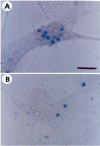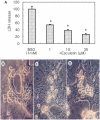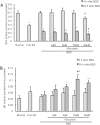Esculetin inhibits N-methyl-D-aspartate neurotoxicity via glutathione preservation in primary cortical cultures
- PMID: 21998617
- PMCID: PMC3188735
- DOI: 10.5625/lar.2011.27.3.259
Esculetin inhibits N-methyl-D-aspartate neurotoxicity via glutathione preservation in primary cortical cultures
Abstract
Recently, loss of endogenous glutathione during N-methyl-D-aspartate (NMDA) receptor-mediated excitotoxic injury, and the resultant overproduction of reactive oxygen species (ROS) through an arachidonic acid cascade process in brain, have been implicated in neuronal damage in various neurodegenerative diseases. Glutathione depletion induced by L-buthionine-(S,R)-sulfoximine (BSO), an inhibitor of glutathione synthesis, is known to cause arachidonic acid-mediated excitotoxicity in primary mixed cortical cultures. The aim of this study was to investigate whether esculetin (6,7-dihydroxycoumarin), an inhibitor of lipoxygenase, protects against neurotoxicity induced by NMDA or BSO. We observed that neurotoxicity induced by NMDA but not kainic acid was attenuated by esculetin. At the same concentration (100 µM), esculetin attenuated the (45)Ca(2+) uptake elevation induced by NMDA. Free radical-mediated neuronal injury induced by H(2)O(2) and xanthine/xanthine oxidase was concentration-dependently blocked by esculetin. Esculetin (1-30 µM) dose-dependently inhibited BSO-induced neuronal injury. In addition, arachidonate-induced neurotoxicity was completely blocked by esculetin. BSO also reduced glutathione peroxidase (GPx) activity, but did not change glutathione reductase (GR) activity 24 h after treatment. Esculetin dose-dependently increased GR activity, but did not alter GPx activity. These findings suggest that esculetin can contribute to the rescue of neuronal cells from NMDA neurotoxicity and that this protective effect occurs partly through NMDA receptor modulation and the sparing of glutathione depletion.
Keywords: Esculetin; L-buthionine-(S,R)-sulfoximine; N-methyl-D-aspartate; cortical cultures; lipoxygenase.
Figures





Similar articles
-
Eugenol protects neuronal cells from excitotoxic and oxidative injury in primary cortical cultures.Neurosci Lett. 1997 Apr 4;225(2):93-6. doi: 10.1016/s0304-3940(97)00195-x. Neurosci Lett. 1997. PMID: 9147382
-
BAPTA/AM, an intracellular calcium chelator, induces delayed necrosis by lipoxygenase-mediated free radicals in mouse cortical cultures.Prog Neuropsychopharmacol Biol Psychiatry. 2001 Nov;25(8):1641-59. doi: 10.1016/s0278-5846(01)00202-0. Prog Neuropsychopharmacol Biol Psychiatry. 2001. PMID: 11642660
-
Potentiation of excitotoxic injury by high concentrations of extracellular reduced glutathione.Neuroscience. 1999;91(2):463-70. doi: 10.1016/s0306-4522(98)00597-1. Neuroscience. 1999. PMID: 10366003
-
Modulatory effect of glutathione status and antioxidants on methylmercury-induced free radical formation in primary cultures of cerebral astrocytes.Brain Res Mol Brain Res. 2005 Jun 13;137(1-2):11-22. doi: 10.1016/j.molbrainres.2005.02.006. Epub 2005 Mar 17. Brain Res Mol Brain Res. 2005. PMID: 15950756
-
Phenidone attenuates oxygen/glucose deprivation-induced neurotoxicity by antioxidant and antiapoptotic action in mouse cortical cultures.Neurosci Lett. 1999 Sep 10;272(2):91-4. doi: 10.1016/s0304-3940(99)00576-5. Neurosci Lett. 1999. PMID: 10507549
Cited by
-
Antimicrobial Activities of Extracts and Isolated Coumarins from the Roots of Four Ferulago Species Growing in Turkey.Iran J Pharm Res. 2019 Summer;18(3):1516-1529. doi: 10.22037/ijpr.2019.1100718. Iran J Pharm Res. 2019. PMID: 32641960 Free PMC article.
-
Urtica dioica leaves modulates muscarinic cholinergic system in the hippocampus of streptozotocin-induced diabetic mice.Metab Brain Dis. 2015 Jun;30(3):803-11. doi: 10.1007/s11011-014-9646-9. Epub 2014 Dec 17. Metab Brain Dis. 2015. PMID: 25514862
-
The α-amylase and α-glucosidase inhibitory activities of the dichloromethane extracts and constituents of Ferulago bracteata roots.Pharm Biol. 2018 Dec;56(1):18-24. doi: 10.1080/13880209.2017.1414857. Pharm Biol. 2018. PMID: 29233045 Free PMC article.
-
Artemisia scoparia and Metabolic Health: Untapped Potential of an Ancient Remedy for Modern Use.Front Endocrinol (Lausanne). 2022 Feb 8;12:727061. doi: 10.3389/fendo.2021.727061. eCollection 2021. Front Endocrinol (Lausanne). 2022. PMID: 35211087 Free PMC article. Review.
-
Prostaglandin actions in established insect cell lines.In Vitro Cell Dev Biol Anim. 2017 May;53(5):421-429. doi: 10.1007/s11626-017-0147-0. Epub 2017 Apr 28. In Vitro Cell Dev Biol Anim. 2017. PMID: 28455813
References
-
- Dumuis A, Sebben M, Haynes L, Pin JP, Bockaert J. NMDA receptors activate the arachidonic acid cascade system in striatal neurons. Nature. 1988;336(6194):68–70. - PubMed
-
- Almeida A, Heales SJ, Bolaños JP, Medina JM. Glutamate neurotoxicity is associated with nitric oxide-mediated mitochondrial dysfunction and glutathione depletion. Brain Res. 1998;790(1-2):209–216. - PubMed
-
- Taylor AL, Hewett SJ. Potassium-evoked glutamate release liberates arachidonic acid from cortical neurons. J Biol Chem. 2002;277(46):43881–43887. - PubMed
-
- Collingridge GL, Singer W. Excitatory amino acid receptors and synaptic plasticity. Trends Pharmacol Sci. 1990;11(7):290–296. - PubMed
-
- Rodriguez-Alvarez J, Blanco I, Patel AJ. Modulation of N-methyl-D-aspartate receptor mediated arachidonic acid release by endogenous nitric oxide in cultured neurons. Neurosci Lett. 1996;218(2):95–98. - PubMed

